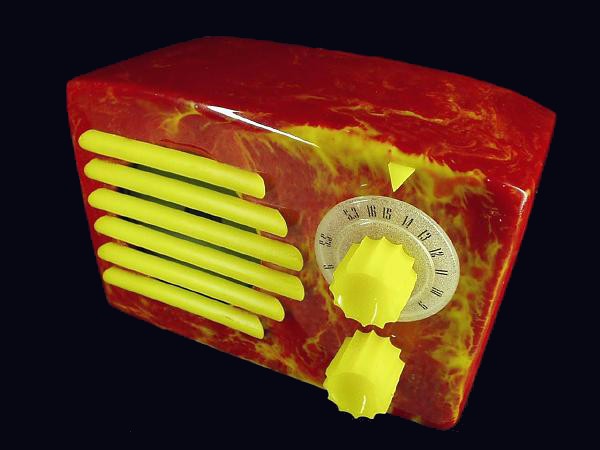Casting a Plastic Radio Case


Having been attracted for years to colorful plastic radios, particularly Catalin, I decided to see if I could recreate one. The word "Catalin," as with Coke or Xerox, is a brand name that in the 1940s became a more universal name for colorful cast phenolic plastics used in radios, jewelry, and cookware. Catalin plastic can be opaque, translucent, solid colored or swirled. You can see examples of Catalin radios in the eBay auction images displayed at the bottom of this page.
Construction Procedure
After I drew up the design I wanted, I made a plexiglass model. On it I painted 8-10 layers of latex to make a mold. Then I mixed two part epoxy with cadmium yellow acrylic paint and red marine epoxy coloring to cast the case.
The yellow louvers were cast in plastic tubes from the hobby shop; the recessed knobs were cast on the hemispherical end of a cigar tube surrounded by straws, arranged gatling gun style. That formed the fluted knobs.
The translucent tuning dial was cast out of the same plastic with a mold that used the top of a spice jar featuring a nice ring. There had to be a better way than waiting for eight layers of latex to dry, and sure enough, hot melt glue makes a dandy mold for small parts.
The translucence was achieved by vigorously mixing the resin & hardener so that tiny air bubbles formed, spreading themselves uniformly throughout the mixture.
I used Microsoft Publisher and my ink jet printer for the dial numbers.
The ring of numbers is printed on overhead projector transparency plastic.
I then cut out the circle and embedded it in the curing epoxy. The edge
and surface imperfections mysteriously and beautifully disappear when it's
embedded.
 |
How does the radio perform? I was able to optimize the circuit so it plays AM at room filling volume, gets 20 locals up to seventy miles away, quite a feat with only two transistors and an internal antenna. |
 |
Here's
what's inside. The two transistor reflex circuit is a supremely elegant
and efficient circuit. The circuit I used was designed by G.W. Short
and published in 1968 in Radio Constructor, a British periodical.
I actually built the circuit first and was looking for a worthy cabinet for it when I got the idea to cast plastic Comparing this picture with the image above, you can see how the tuning and volume knob shafts mate with the knobs. The audio transformer (green) is visible on the chassis close to the speaker. |
 |
This
side view shows the bending of the chassis, which started out as a 4" x
10" piece of aluminum from the hardware store. The ferrite bar antenna
(with the green end at top) is from a radio I found in a garbage can on
the side of the road.
I etched the circuit board and modified a few components to optimize the circuit. In addition to using an audio transformer to feed a speaker, I used modern transistors (2N2222), which required experimenting with different bias resistors. Otherwise the circuit is the same as in the schematic below. During final assembly I shortened the bottom shaft to make it match. |
 |
This back
view is what shows when you take the back off the radio. The battery is
situated for easy access.
I've had the gears for years in my junkbox; they are from a defunct copier, and I intended to use them in part a of a telescope drive. Here they are configured as a fine tuning control. Because tuning capacitors only rotate 180 degrees, the 1:2 ratio also permits the dial numbers to be spread around the full circumference of the dial. |
Schematic

Instead of an earphone, my build uses a Radio Shack 1000:8 ohm transformer connected to a 25 ohm speaker.
The entire reflex transistor
construction article can be found here.
Then scroll down to Silicon
Reflex, by G.W. Short.
Catalin Radios: The Real Thing
Radios similar to the following
fetch several hundred to several thousand dollars on ebay.
Enjoy the eye candy!
 |
 |
 |
 |
 |
 |
January 23, 2003